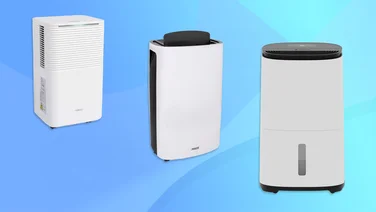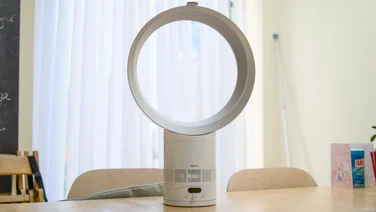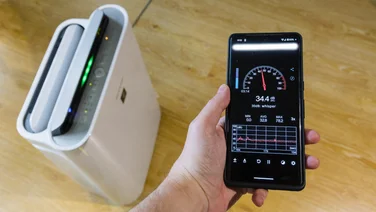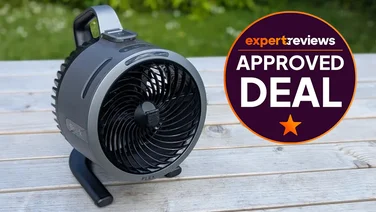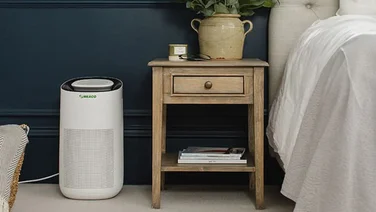To help us provide you with free impartial advice, we may earn a commission if you buy through links on our site. Learn more
- Best air cooler: At a glance
- The best air coolers to buy in 2024
- 1. Black+Decker Manual 2-in-1 Air Cooler: Best air cooler for quick cooling
- 2. Princess Smart Air Cooler: Best air cooler for control options
- 3. Honeywell TC09PM: Best air cooler for ease of use
- 4. Evapolar evaCHILL: Best desktop air cooler
- How do air coolers work?
- How I test air coolers
- Things to consider before buying an air cooler

If you’re looking for a cost-effective way to reduce the temperature of your home in the sweltering summer months, you can’t do much better than an air cooler. The best air coolers are a big step up from a standard fan, and although they won’t produce such a noticeable cooling effect, they’re much more convenient than a portable air conditioner.
I’ve been putting the industry’s best air coolers through their paces for the past three summers since 2021, and I’ve compiled a definitive list of the products worth buying. I’ve tested each one extensively and given an award based on its strengths and weaknesses relative to the competition.
If you’re in a hurry, you can check out our at-a-glance list below to get my top picks for every occasion, and better yet, you can keep scrolling down to get an in-depth explanation of how I test each air cooler and what you should consider when buying one.
READ NEXT: Best air purifiers
Best air cooler: At a glance
| Best air cooler for rapid cooling | Black+Decker Manual 2-in-1 Air Cooler (~£90) | |
| Best air cooler for control options | Princess Smart Air Cooler (~£120) | |
| Best air cooler for ease of use | Honeywell TC09PM Portable Air Cooler (~£140) | |
| Best air cooler for desktops | Evapolar evaCHILL (~£88) |
The best air coolers to buy in 2024
1. Black+Decker Manual 2-in-1 Air Cooler: Best air cooler for quick cooling
Price when reviewed: £90 | Check price at Amazon

- Great for… rapid, effective cooling
- Not so great for… noise levels
What impressed me most about this air cooler was the speed at which it produced cold air. Used with the two included freezer blocks, it reduced the temperature in my testing room quicker than the other options on this list.
Oscillating vertical louvres ensured cool air was spread out broadly, while the horizontal louvres allowed me to angle the airflow up or down as required. The cooler is designed to humidify as it cools, but it has a fan-only option if you simply want to circulate air around the room. It’s also one of the few coolers I’ve seen with a built-in timer, so you can set it to chill before bedtime.
Its only significant drawbacks are that it’s awkward to remove the water tank and filter block for cleaning and that it creates a reasonably loud 60 dBA of noise at its highest speed.
Key specs – Tank capacity: 7l; Air circulation: 234m³/hr; Speeds: 3; Oscillation: Yes; Freezer blocks: Yes; Extra features: No; Power consumption: 65W; Dimensions: 300 x 301 x 770mm (WDH); Weight: 6kg
2. Princess Smart Air Cooler: Best air cooler for control options
Price when reviewed: £120 | Check price at Amazon

- Great for… multiple control options
- Not so great for… tank capacity
This option from Dutch brand Princess can be operated using a remote, smartphone app and voice commands, making it the top pick for those in search of multiple control options.
Commands can be sent to the cooler via the Princess Home app, Siri, Alexa or Google Assistant, and I found using verbal commands to turn the unit off and change modes particularly useful. Natural mode varies the fan speed for an outdoor breeze effect, while Sleep mode ramps down the speed as you doze off. These supplement the three fan speeds nicely and a pair of icepacks are included to speed up cooling.
Tank capacity is limited to just 3.5l, meaning it won’t last much more than a day, and the cooler is louder than most, even at its lowest setting. But performance is impressive for the money and you won’t find this level of smart control anywhere else.
Key specs – Tank capacity: 3.5l; Air circulation: 1,188m³/hr; Speeds: 3; Oscillation: Yes; Freezer blocks: Yes; Extra features: Humidification, Fan, Smart App, Timer, Natural and Sleep modes; Power consumption: 70W; Dimensions: 280 x 220 x 760mm (WDH); Weight: 4kg
3. Honeywell TC09PM: Best air cooler for ease of use

Price when reviewed: £140 | Check price at Amazon
- Great for… a simple user experience
- Not so great for… maximum cooling
Air coolers don’t get any easier to use than the TC09PM from American manufacturer Honeywell. It has two dials; one to control fan speed and one to select whether you want it to cool, oscillate or do both simultaneously. Simplicity may be its key selling point, but the cooler performed admirably in testing, dishing out a consistently good, cooling airflow. Its 9l water tank is larger than its rivals too, meaning it can be left for a couple of days without needing a refill.
Refilling is a doodle thanks to a pull-out door at the rear of the cooler. This design does mean there’s no space to add freezer blocks, though, which limits how cool it can get. The honeycomb cooling membrane requires cleaning slightly more regularly than other options I’ve tested, but I think that’s a price worth paying given the blissfully straightforward user experience.
Key specs – Tank capacity: 9l; Air circulation: 300m³/hr; Speeds: 3; Oscillation: Yes; Freezer blocks: No; Extra features: Humidification; Power consumption: 65W; Dimensions: 301 x 280 x 660mm (WDH); Weight: 4.6kg
4. Evapolar evaCHILL: Best desktop air cooler
Price when reviewed: £88 | Check price at Evapolar

- Great for… clean, effective air circulation
- Not so great for… big rooms
The evaCHILL is pricier than most USB-powered desktop coolers but blew me away during testing. It circulated air more effectively than cheaper units and its basalt-based filters, which slow the build-up of bacteria, stayed sterile over long-term use. This meant the cooler avoided the kind of unpleasant smells that often plague desktop models if not cleaned daily.
The tank may only be 800ml but provides around nine hours of effective cooling and can be filled from the top, which makes the refilling process very easy. Cycling through the three speeds is a breeze using the one-button controls, and the evaCHILL is also significantly quieter than its rivals when cooling. Its size means it can only cool one person, and the evaporative cartridge needs replacing every three or four months, but if you’re looking to reduce the temperature at your desk or in your home office, this cooler has you covered.
Key specs – Tank capacity: 800ml; Air circulation: 83.25m³/hr; Speeds: 3; Oscillation: Yes; Freezer blocks: No; Extra features: Humidification; Power consumption: 7.5W; Dimensions: 170 x 170 x 172mm (WDH); Weight: 750g
How do air coolers work?
There are two basic types of air coolers: compact, USB-powered ones designed to cool a narrow area from a table or desktop, and larger options that look a little like portable air conditioners and seek to cool larger spaces.
Both use fans to blow air through an absorbent pad or membrane structure. As water on the pad or membrane evaporates, it cools the air around it and this cold air is then blown out into the room by the fan. The cooler the water on the pad or membrane, the cooler the air that is produced, which is why some air coolers come with ice packs or freezing blocks.
It’s important to note that this method of cooling is not as effective as air conditioning and won’t suddenly transform a roasting room into a chilled-out sanctuary. It’s much cheaper and convenient, however, and uses less energy, too.
READ NEXT: Best cooling mattresses
How I test air coolers
Choosing products for the page
All of the products that feature on this page have either outperformed similarly priced rivals in one or more of the tests detailed below or have a unique selling point that makes them worth your consideration.
Because different air coolers have different strengths and weaknesses, I attempt to select a range of products that meet a variety of needs. But rest assured, if an air cooler fails at its primary task of cooling me down, you won’t find it on this page.
Testing tools and metrics
A range of tools are used to test the performance of air coolers across various areas. I use a handheld anemometer to measure the speed of airflow generated by the air cooler in metres per second and then convert it into metres per hour, while a digital thermometer is used to record changes in ambient room temperature.The tool of choice for tracking changes in humidity is an air quality sensor, while a smartphone sound meter is used to record noise levels at both minimum and full power. Finally, I use an AC passthrough power meter to check the energy consumption at both levels.
There are some things I can’t test using tools, such as how intuitive a product is to use or how easy it is to fill or clean. By spending extended periods with a product and regularly using its full range of features and functionality, I can assess these more abstract qualities relative to the competition.
Testing conditions and process
My air cooler testing is conducted in hot rooms during the summer months as these are typically the conditions in which they’re used. I close any doors or windows to maximise the heat and minimise the impact of external factors such as wind on a cooler’s ability to cool its environment.
Things to consider before buying an air cooler
Size and portability
- Desktop coolers are very compact and easy to move, but less effective than larger options. Larger units have greater cooling power, but you’ll need to find more space to accommodate them. If you plan to move your cooler from room to room regularly, I suggest looking for an option with rolling feet.
Fan speeds and oscillation
- Most air coolers offer a choice of fan speeds, but larger ones often use movable louvres that move airflow left and right and up and down. These are handy as they allow you to direct the cooling breeze as you see fit.
READ NEXT: Best bedroom fans
Ice packs or freezer blocks
- These reduce the temperature of the water absorbed by an air cooler’s pad or membrane, resulting in cooler air when it evaporates. For optimal cooling power, look for a cooler that comes with these.
Built-in humidification
- Some air coolers offer humidifier settings that actively put moisture into the air. This is useful for hot and dry rooms but isn’t advisable if the air is already humid.
READ NEXT: Best humidifiers
Tank capacity
- Different air coolers use water at different rates but generally speaking, a larger tank capacity means you’ll be able to leave it running for longer. The presence of an open water tank does mean there is a risk of spillage, which is something to be aware of, particularly if you’re using a desktop cooler near a PC or laptop.
Cleaning
- To avoid nasty smells, you’ll need to wash your air cooler’s pad or membrane regularly and ensure the water is changed regularly. Some smaller coolers, however, simply require you to change a filter every few months.






